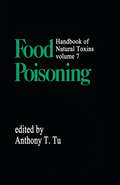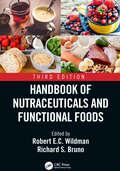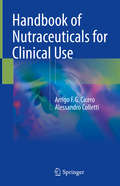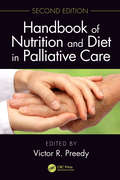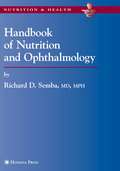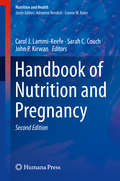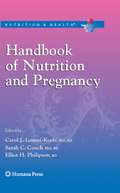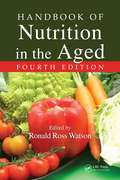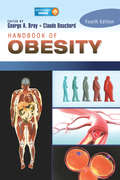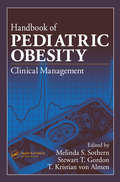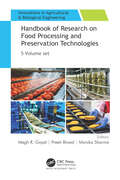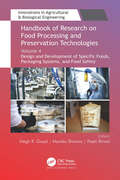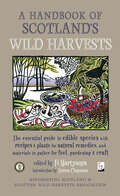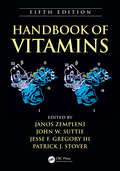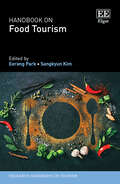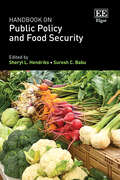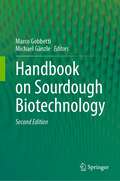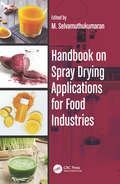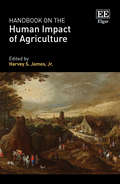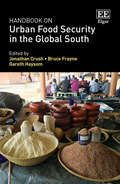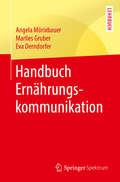- Table View
- List View
Handbook of Natural Toxins: Food Poisoning
by Anthony T. TuThis resource discusses all aspects of food poisoning and its sources such as bacteria, plant, and fungus - presenting the pathogens and food toxins in detail. Featuring contributions from over 30 leading authorities in the field, Food Poisoning ...: describes bacterial food contaminants including staphylococcal, salmonellae, E. coli, Clostridium perfringens, Bacillus cereus, cholera, and botulism; covers the prevention and treatment of mushroom and other poisonings from grains and plant-type foods; explains how to aid allergic reactions resulting from eating certain foods; identifies which kinds of seafood may cause severe poisoning; explores teratogenic aspects of food poisoning, outlining which foods pregnant women should avoid; and shows how those sensitive to nitrosamines can avoid such food poisoning.;Extensively referenced with more than 2200 literature citations, Volume 7: Food Poisoning serves as essential reading for toxicologists, microbiologists, dietitians and nutritionists, public health officials, food scientists and technologists, agricultural chemists and biochemists, bacteriologists, and graduate-level students in food science and toxicology.
Handbook of Nutraceuticals and Functional Foods
by Robert E.C. Wildman and Richard S. BrunoThe field of functional foods along with their bioactive food components has grown tremendously over the past decades. Often guided by hypothesis-generating epidemiological observations, discoveries from basic science studies and controlled trials in humans have provided critical evidence to help establish an optimal diet that alleviates chronic disease risk. These advances have also driven efforts by the food and nutraceutical industries to establish and market health claims, formulate extra-value foods, and even generate new health foods for human benefit.Handbook of Nutraceuticals and Functional Foods, Third Edition, compiles the data from experts in the field that potentiates the already established credibility of the earlier editions. In its three-section format, it provides an authoritative summary of the prophylactic and/or medicinal benefits of natural foods and their constituents that are linked to favorable health outcomes. Beginning with an overview of the field and associated regulations, each chapter describes the chemical properties, bioactivities, dietary sources, and evidence of these health-promoting dietary constituents.Features:• Summarizes plant- and animal-based functional foods and their bioactive components• New chapters on cannabidiol and scientific, legal, and regulatory considerations; green tea and nutraceutical applications; and herbal nutraceuticals and insulin resistance• Includes information on functional food beverages including coffee, green tea, and dairy milk• Discusses antioxidant and anti-inflammatory activities of vitamin E, anthocyanins and other (poly)phenolic compounds, and carotenoids• Provides an update on the health benefits and requirements of protein and performance and therapeutic application and safety of creatine.
Handbook of Nutraceuticals and Functional Foods
by Robert E. C. Wildman Richard S. BrunoThe field of functional foods along with their bioactive food components has grown tremendously over the past decades. Often guided by hypothesis-generating epidemiological observations, discoveries from basic science studies and controlled trials in humans have provided critical evidence to help establish an optimal diet that alleviates chronic disease risk. These advances have also driven efforts by the food and nutraceutical industries to establish and market health claims, formulate extra-value foods, and even generate new health foods for human benefit.Handbook of Nutraceuticals and Functional Foods, Third Edition, compiles the data from experts in the field that potentiates the already established credibility of the earlier editions. In its three-section format, it provides an authoritative summary of the prophylactic and/or medicinal benefits of natural foods and their constituents that are linked to favorable health outcomes. Beginning with an overview of the field and associated regulations, each chapter describes the chemical properties, bioactivities, dietary sources, and evidence of these health-promoting dietary constituents.Features:• Summarizes plant- and animal-based functional foods and their bioactive components• New chapters on cannabidiol and scientific, legal, and regulatory considerations; green tea and nutraceutical applications; and herbal nutraceuticals and insulin resistance• Includes information on functional food beverages including coffee, green tea, and dairy milk• Discusses antioxidant and anti-inflammatory activities of vitamin E, anthocyanins and other (poly)phenolic compounds, and carotenoids• Provides an update on the health benefits and requirements of protein and performance and therapeutic application and safety of creatine.
Handbook of Nutraceuticals for Clinical Use
by Arrigo F.G. Cicero Alessandro CollettiThis handbook provides key information on the clinical use of nutraceuticals, an increasingly common practice grounded in an understanding of the pharmacological activities of natural compounds and clinical evidence of efficacy and safety. Each chapter examines the effects of nutraceuticals in different therapeutic contexts, including nutraceuticals active on the digestive system, heart, lipid and glucose metabolism, and immune system. The authors also address relevant concerns such as relative and absolute contraindications, range of tested doses (efficacious and safe), possible side effects and pharmacological interactions, and the scientific level of clinical evidence for each product. Despite the availability of a large number of nutraceuticals on the market, the same compound is often offered by different industries at different dosages and concentrations, with different titration and often with different suggestions of efficacy. Available academic books on nutraceuticals prioritize summarizing information or focus on the pharmacological aspects on cells or animals models rather than on proof in humans.The handbook takes a unique and practical approach intended to assist clinicians, pharmacologists, nutritionists, and dietitians considering prescribing nutraceuticals for therapeutic use. Renowned expert Professor Arrigo Cicero is known internationally for his work in nutraceuticals, and currently serves as President of the Italian Nutraceutical Society.
Handbook of Nutrition and Diet in Palliative Care, Second Edition
by Victor R. PreedyHandbook of Nutrition and Diet in Palliative Care, Second Edition, is a comprehensive guide, providing exhaustive information on nutrition and diet in terminal and palliative care. It covers physical, cultural and ethical aspects, bridging the intellectual divide in being suitable for novices and experts alike. Following in the tradition of its predecessor, chapters contain practical methods, techniques, and guidelines along with a section on applications to other areas of palliative care. Each chapter features key facts highlighting important areas, summary points, and ethical issues. FEATURES • Use of cannabinoids in palliative nutrition care • Pain control in palliative care • Communications in palliative/end-of-life care: aspects of bad news • Anorexia in cancer: appetite, physiology, and beyond • Palliative care in severe and enduring eating disorders • Linking food supplementation and palliative care in HIV • Eating-related distress in terminally ill cancer patients and their family members • Palliative care of gastroparesis • Preoperative nutrition assessment and optimization in the cancer patient • Childhood leukemia, malnutrition, and mortality as components of palliative care • End-of-life decisions in persons with neurodevelopmental disorders • Resources: listing web sites, journals, books and organizations
Handbook of Nutrition and Diet in Palliative Care, Second Edition
by Victor R. PreedyHandbook of Nutrition and Diet in Palliative Care, Second Edition, is a comprehensive guide, providing exhaustive information on nutrition and diet in terminal and palliative care. It covers physical, cultural and ethical aspects, bridging the intellectual divide in being suitable for novices and experts alike. Following in the tradition of its predecessor, chapters contain practical methods, techniques, and guidelines along with a section on applications to other areas of palliative care. Each chapter features key facts highlighting important areas, summary points, and ethical issues. FEATURES • Use of cannabinoids in palliative nutrition care • Pain control in palliative care • Communications in palliative/end-of-life care: aspects of bad news • Anorexia in cancer: appetite, physiology, and beyond • Palliative care in severe and enduring eating disorders • Linking food supplementation and palliative care in HIV • Eating-related distress in terminally ill cancer patients and their family members • Palliative care of gastroparesis • Preoperative nutrition assessment and optimization in the cancer patient • Childhood leukemia, malnutrition, and mortality as components of palliative care • End-of-life decisions in persons with neurodevelopmental disorders • Resources: listing web sites, journals, books and organizations
Handbook of Nutrition and Ophthalmology (Nutrition and Health)
by Richard David SembaThe Handbook of Nutrition in Ophthalmology is the first general text on nutrition and eye health created for physicians, nutritionists, and researchers. The author provides important links between the epidemic of obesity and implications it has for eye disease and blindness. The volume also includes chapters addressing nutritional aspects of preventing eye disease in diabetes mellitus and other optical neuropathies, making this a unique book.
Handbook of Nutrition and Pregnancy (Nutrition and Health)
by Carol J. Lammi-Keefe Sarah C. Couch John P. KirwanThis easy to use text provides practitioners and researchers with a global view of current and emerging issues concerned with successful pregnancy outcomes and approaches that have been successful or show promise in ensuring a successful pregnancy. The fully updated and revised second edition expands its scope with topics not covered in the first edition including pregnancy and military service; sleep disorders during pregnancy; the gut microbiome during pregnancy and the newborn; requirement for vitamin D in pregnancy; the environment—contaminants and pregnancy; preeclampsia and new approaches to treatment; health disparities for whites, blacks, and teen pregnancies; depression in pregnancy—role of yoga; safe food handling for successful pregnancy outcome; relationship of epigenetics and diet in pregnancy; caffeine during pregnancy; polycystic ovary syndrome; US Hispanics and preterm births; celiac disease and pregnancy; cannabis use during pregnancy.The second edition of Handbook of Nutrition and Pregnancy will be a valuable resource for clinicians and other healthcare professionals who treat and counsel women of child-bearing age and pregnant women.
Handbook of Nutrition and Pregnancy (Nutrition and Health)
by Carol J. Lammi-Keefe Sarah C. Couch Elliot Philipson E. A. ReeseThis is an easy-to-use handbook written for the clinician and other healthcare professionals who treat and counsel pregnant women and women of child-bearing age. The authors provide historical perspective and background to support recommendations which are provided in each chapter. Importantly for the practitioners, recommendations and guidelines have been summarized and provided in tables that are easy to locate and interpret. This book discusses relevant topics in the scientific community such as determining to what extent prenatal and perinatal environmental factors are linked to childhood and adult obesity and chronic diseases.
Handbook of Nutrition in the Aged
by Ronald Ross WatsonDetailed Review of Nutritional Therapies Used to Combat Elderly Health IssuesThe combination of the aging baby-boomer generation and their increased longevity has been fortunately met with increased research and greater understanding of health promotion and disease prevention in the elderly. Handbook of Nutrition in the Aged: Fourth Edition shares
Handbook of Obesity, Two-Volume Set
by George A. Bray Claude BouchardThis 2 volume set comprises of the 3rd edition of Volume 1 and the 4th edition of Volume 2, both published in 2014.In recent years, we've developed a much better grasp of the biological and other factors associated with the development of obesity. New clinical trials, discoveries related to drug use, and greater understanding of the benefits of wei
Handbook of Pediatric Obesity: Clinical Management
by Melinda S. Sothern T. Kristian Von Almen Stewart T. GordonA compilation of management, medical, nutrition, psychological, and physical activity facts, models, theories, interventions, and evaluation techniques, the Handbook of Pediatric Obesity: Clinical Management is the most clinically appropriate and scientifically supported source of information available for pediatric health care and research profess
Handbook of Research on Food Processing and Preservation Technologies: 5-volume set (Innovations in Agricultural & Biological Engineering)
by Megh R. Goyal Preeti Birwal Monika SharmaThe Handbook of Research on Food Processing and Preservation Technologies is a 5-volume collection that highlights various design, development, and applications of novel and innovative strategies for food processing and preservation. The roles and applications of minimal processing techniques (such as ozone treatment, vacuum drying, osmotic dehydration, dense phase carbon dioxide treatment, pulsed electric field, and high-pressure assisted freezing) are discussed, along with a wide range of other applications. The handbook also explores some exciting computer-aided techniques emerging in the food processing sector, such as robotics, radio frequency identification (RFID), three-dimensional food printing, artificial intelligence, etc. Some emphasis has also been given on nondestructive quality evaluation techniques (such as image processing, terahertz spectroscopy imaging technique, near infrared, Fourier transform infrared spectroscopy technique, etc.) for food quality and safety evaluation. The significant roles of food properties in the design of specific foods and edible films have been elucidated as well. The first volume in this set, Volume 1: Nonthermal and Innovative Food Processing Methods, provides a detailed discussion of many nonthermal food process techniques. These include high-pressure processing, ultraviolet light technology, microwave-assisted extraction, high pressure assisted freezing, microencapsulation, dense phase carbon dioxide aided preservation, to name a few. Volume 2: Nonthermal Food Preservation and Novel Processing Strategies introduces several new food processing and preservation technologies that have been investigated by researchers and which have the potential to increase shelf life and preserve the quality of foods. It focuses on nonthermal techniques such as high-pressure processing, ultrasonication of foods, microwave vacuum dehydration, thermoelectric refrigeration technology, advanced methods of encapsulation, ozonation, electrospinning, and mechanical expellers for dairy, food, and agricultural processing. Volume 3: Computer-Aided Food Processing and Quality Evaluation Techniques presents a number of exciting applications of computer-aided techniques for quality evaluation and secure food quality. The chapter authors present emerging nonthermal approaches for food processing and preservation including detailed discussions on color measurement techniques, RFID, 3D-food printing, potential of robotics, artificial intelligence, terahertz spectroscopy imaging technique, instrumentation techniques and transducers, and more. Volume 4: Design and Development of Specific Foods, Packaging Systems, and Food Safety presents new research on health food formulation, advanced packaging systems, and toxicological studies for food safety. This book covers in detail the design of functional foods for beneficial gut microflora and microbiota; composite probiotic dairy products; encapsulation technology for development of specific foods; edible, biodegradable, and alternative food packaging technologies; ozonation in surface modification of food packaging polymers; characterization applications and safety aspects of nanomaterials used in food and dairy industry; and more. Volume 5: Emerging Techniques for Food Processing, Quality, and Safety Assurance discusses various emerging techniques for food preservation, formulation, and nondestructive quality evaluation techniques. Each chapter covers major aspects pertaining to principles, design, and applications of various food processing and nondestructive quality evaluation techniques, such low-temperature-based ultrasonic drying, hypobaric processing, viability of high-pressure technology, pulsed electric fields in food preservation, green nanotechnology, advanced methods of encapsulation, the use of robotic engineering for quality and safety, and more. Together, the 5 volumes of the Handbook of Research on Food Processing and Preservation Technologies<
Handbook of Research on Food Processing and Preservation Technologies: Volume 4: Design and Development of Specific Foods, Packaging Systems, and Food Safety (Innovations in Agricultural & Biological Engineering)
by Megh R. Goyal Monika Sharma Preeti BirwalThe Handbook of Research on Food Processing and Preservation Technologies is a valuable 5-volume collection that illustrates various design, development, and applications of novel and innovative strategies for food processing and preservation. The roles and applications of minimal processing techniques (such as ozone treatment, vacuum drying, osmotic dehydration, dense phase carbon dioxide treatment, pulsed electric field, and high-pressure assisted freezing) are discussed, along with a wide range of applications. The handbook also explores some exciting computer-aided techniques emerging in the food processing sector, such as robotics, radio frequency identification (RFID), three-dimensional food printing, artificial intelligence, etc. Some emphasis has also been given on nondestructive quality evaluation techniques (such as image processing, terahertz spectroscopy imaging technique, near infrared, Fourier transform infrared spectroscopy technique, etc.) for food quality and safety evaluation. The significant roles of food properties in the design of specific foods and edible films have been elucidated as well. Volume 4: Design and Development of Specific Foods, Packaging Systems, and Food Safety presents new research on health food formulation, advanced packaging systems, and toxicological studies for food safety. This volume covers in detail the design of functional foods for beneficial gut microflora, design of specific foods for gut microbiota, composite probiotic dairy products: concepts and design with a focus on millets, encapsulation technology for development of specific foods, prospects of edible and alternative food packaging technologies, recent advancements in edible and biodegradable materials for food packaging, potential of ozonation in surface modification of food packaging polymers, characterization applications and safety aspects of nanomaterials used in food and dairy industry, toxic effects of tinplate corrosion, and mitigation measures in canned foods. Other volumes in the set include: Volume 1: Nonthermal and Innovative Food Processing Methods Volume 2: Nonthermal Food Preservation and Novel Processing Strategies Volume 3: Computer-Aided Food Processing and Quality Evaluation Techniques Volume 5: Emerging Techniques for Food Processing, Quality, and Safety Assurance The book helps to provide an understanding of different food formulations and development of edible packaging techniques with emphasis on the assessment of food product safety and quality. The book also provides information on various methods of formulation for development of new and safe products. Together with the other volumes in the set, Handbook of Research on Food Processing and Preservation Technologies will be a valuable resource for researchers, scientists, students, growers, traders, processors, industries, and others.
Handbook of Research on Food Processing and Preservation Technologies: Volume 4: Design and Development of Specific Foods, Packaging Systems, and Food Safety (Innovations in Agricultural & Biological Engineering)
by Megh R. Goyal Monika Sharma Preeti BirwalThe Handbook of Research on Food Processing and Preservation Technologies is a valuable 5-volume collection that illustrates various design, development, and applications of novel and innovative strategies for food processing and preservation. The roles and applications of minimal processing techniques (such as ozone treatment, vacuum drying, osmotic dehydration, dense phase carbon dioxide treatment, pulsed electric field, and high-pressure assisted freezing) are discussed, along with a wide range of applications. The handbook also explores some exciting computer-aided techniques emerging in the food processing sector, such as robotics, radio frequency identification (RFID), three-dimensional food printing, artificial intelligence, etc. Some emphasis has also been given on nondestructive quality evaluation techniques (such as image processing, terahertz spectroscopy imaging technique, near infrared, Fourier transform infrared spectroscopy technique, etc.) for food quality and safety evaluation. The significant roles of food properties in the design of specific foods and edible films have been elucidated as well. Volume 4: Design and Development of Specific Foods, Packaging Systems, and Food Safety presents new research on health food formulation, advanced packaging systems, and toxicological studies for food safety. This volume covers in detail the design of functional foods for beneficial gut microflora, design of specific foods for gut microbiota, composite probiotic dairy products: concepts and design with a focus on millets, encapsulation technology for development of specific foods, prospects of edible and alternative food packaging technologies, recent advancements in edible and biodegradable materials for food packaging, potential of ozonation in surface modification of food packaging polymers, characterization applications and safety aspects of nanomaterials used in food and dairy industry, toxic effects of tinplate corrosion, and mitigation measures in canned foods. Other volumes in the set include: Volume 1: Nonthermal and Innovative Food Processing Methods Volume 2: Nonthermal Food Preservation and Novel Processing Strategies Volume 3: Computer-Aided Food Processing and Quality Evaluation Techniques Volume 5: Emerging Techniques for Food Processing, Quality, and Safety Assurance The book helps to provide an understanding of different food formulations and development of edible packaging techniques with emphasis on the assessment of food product safety and quality. The book also provides information on various methods of formulation for development of new and safe products. Together with the other volumes in the set, Handbook of Research on Food Processing and Preservation Technologies will be a valuable resource for researchers, scientists, students, growers, traders, processors, industries, and others.
A Handbook of Scotland's Wild Harvests: The Essential Guide to Edible Species, with Recipes and Plants for Natural Remedies, and Materials to Gather for Fuel, Gardening and Craft
by Scottish Wild Harvests Association Reforesting Scotland"The exciting thing about this book is the number of unusual flavours and species it highlights" (Andrew Fairlie, Gleneagles) This inspirational guide is bursting with invaluable know-how on Scotland's wild harvest, covering what, where, when and how you can use your bounty in sustainable ways - from the most useful and widespread of species to the less well-known, and from leaves and berries to saps, seeds, seaweeds, mosses and wood. Recipes from Scottish kitchens include nettle brose, blaeberry muffins and creative dishes from a surprisingly wide range of species. Learn how to begin or extend a repertoire of wild foods and materials that can be used as dyes, remedies and around the home.
Handbook of Vitamins
by Janos Zempleni John W. Suttie Patrick J. Stover Jesse F. GregoryWithin the last few years, knowledge about vitamins has increased dramatically, resulting in improved understanding of human requirements for many vitamins. This new edition of a bestseller presents comprehensive summaries that analyze the chemical, physiological, and nutritional relationships, as well as highlight newly identified functions, for a
Handbook on Food Tourism (Research Handbooks in Tourism series)
This Handbook on Food Tourism provides an overview of the past, present, and future of research traditions, perspectives, and concerns about the food tourism phenomenon. Taking a multidisciplinary approach, it contributes to the historical and anthropological understanding of the nexus between food, society, and tourism that underpins the divergent business and marketing efforts in tourism today.Expert contributors from across the globe not only explore the theoretical and conceptual foundations of food tourism research, but also address the significance of the multistakeholder nature of tourism in the context of food tourism development. Chapters present empirical research using quantitative and qualitative methods, conceptual papers and critical literature reviews employing archival research methods and informetric mapping, and analysis of secondary data from social, political, and environmental sources. Rich with information and data about diverse socio-cultural and environmental issues, this Handbook consolidates knowledge on the studies of food tourism from around the world and provides a vision for future research.Covering the breadth of food tourism research, this Handbook will be a fundamental reference work for researchers, academics, and students in tourism management, human geography, social and cultural geography, and business and management. It will similarly appeal to professionals, local authorities, and local food and tourism industries and businesses.
Handbook on Public Policy and Food Security
The Handbook on Public Policy and Food Security provides multi-disciplinary insights into food security analysis across the Sustainable Development Goals (SDGs). As food security is an essential outcome and a part of sustainable and healthy food systems, this Handbook addresses the urgent need to provide a comprehensive overview of the field’s current developments.Paired chapters focuses on a specific SDG in turn, presenting an overview and using qualitative and quantitative methodological approaches to assess the impact of food security on the attainment of the specific goal, and the evaluation of the impact of the goal on food security. This Handbook brings together experts in the field who advocate for a food systems approach, highlighting how various components of a food system function together to achieve the goal of food security for all. The cross-policy themes covered extend beyond the SDGs, proving relevant for public policy and food security in the foreseeable future. This erudite Handbook will be highly informative for academics, researchers and students in agricultural economics, development studies, human geography, human rights and comparative social policy. It will also be beneficial for professionals working in public policy, NGOs and multilateral organisations who are interested in understanding food security and nutrition monitoring.
Handbook on Sourdough Biotechnology
by Marco Gobbetti Michael GänzleBread and leavened bakery products have been essential to human nourishment for millennia. Traditionally, bread production has relied on the use of sourdough as a leavening agent and to impart a characteristic quality to baked goods. In recent years, improved understanding of the biodiversity and microbial ecology of sourdough microbiota, the discovery of new species, the improved management and monitoring of its meta-community and the commercialization of innovative products have vastly expanded the potential of sourdough fermentation for making baked goods. For example, raw materials such as cereals, pseudo-cereals, ancient grains, and gluten-free substrates, as well as a large number of baked good varieties (e.g., typical and industrial breads, sweet baked goods, gluten-free products) may benefit from advances in sourdough fermentation. In addition, biotechnological tools and culture properties have been discovered to improve both the shelf life and the sensory and textural qualities of baked goods, as well as their nutritional and health-promoting properties.Now in its second edition, the Handbook on Sourdough Biotechnology remains the only book dedicated completely to sourdough biotechnology with the contribution of the most experienced researchers from the field. It reviews the history of sourdough and the potential of sourdough fermentation in the production of bread and baked goods. A thorough discussion of the various processing steps includes the chemical properties of the raw matter, the taxonomy, diversity, and metabolic properties of starter yeasts and lactic acid bacteria, and the effects of sourdough fermentation on the shelf life and the sensory, textural, nutritional, and health-promoting properties of baked goods.
Handbook on Spray Drying Applications for Food Industries
by M. SelvamuthukumaranSpray drying is a mechanical process by which materials in liquid form can be converted into solid form such as powders. It is a rapid, continuous, cost-effective, reproducible and scalable process for producing dry powders from a fluid material by atomization through an atomizer into a hot drying gas medium, usually air. The Handbook on Spray Drying Applications for Food Industries deals with recent techniques adopted in spray drying systems for drying a vast array of food products, novel and emerging tools used for spray drying of antioxidant rich products, optimized conditions used for extraction and production of herbal powders by using spray drying techniques, and problems encountered during spray drying of acid and sugar rich foods and also various herbal powders. The book discusses the encapsulation of flavors by using the spray drying process providing a comparison with other encapsulation techniques. It reviews the retention of bioactive compounds and the effect of different parameters on bioactive compounds during spray drying of juice. Moreover, the book explains the effect of novel approaches of spray drying on nutrients. The book addresses strategies adopted for retention of nutrients and survival of probiotic bacteria during spray drying processing. It also identifies packaging material needed for enhanced product stability. The safety and quality aspects of manufacturing spray dried food products are discussed. Key Features: Describes the design of high performance spray drying systems Highlights the strategy adopted for maximizing the yield potential of various spray dried food products Discusses strategies adopted for retention of nutrients and survival of probiotic bacteria during spray drying process Contains charts, procedure flow sheets, tables, figures, photos, and a list of spray drying equipment suppliers This book will benefit entrepreneurs, food scientists, academicians and students by providing in-depth knowledge about spray drying of foods for quality retention and also for efficient consumer acceptability of finished products.
Handbook on Spray Drying Applications for Food Industries
by M. SelvamuthukumaranSpray drying is a mechanical process by which materials in liquid form can be converted into solid form such as powders. It is a rapid, continuous, cost-effective, reproducible and scalable process for producing dry powders from a fluid material by atomization through an atomizer into a hot drying gas medium, usually air. The Handbook on Spray Drying Applications for Food Industries deals with recent techniques adopted in spray drying systems for drying a vast array of food products, novel and emerging tools used for spray drying of antioxidant rich products, optimized conditions used for extraction and production of herbal powders by using spray drying techniques, and problems encountered during spray drying of acid and sugar rich foods and also various herbal powders. The book discusses the encapsulation of flavors by using the spray drying process providing a comparison with other encapsulation techniques. It reviews the retention of bioactive compounds and the effect of different parameters on bioactive compounds during spray drying of juice. Moreover, the book explains the effect of novel approaches of spray drying on nutrients. The book addresses strategies adopted for retention of nutrients and survival of probiotic bacteria during spray drying processing. It also identifies packaging material needed for enhanced product stability. The safety and quality aspects of manufacturing spray dried food products are discussed. Key Features: Describes the design of high performance spray drying systems Highlights the strategy adopted for maximizing the yield potential of various spray dried food products Discusses strategies adopted for retention of nutrients and survival of probiotic bacteria during spray drying process Contains charts, procedure flow sheets, tables, figures, photos, and a list of spray drying equipment suppliers This book will benefit entrepreneurs, food scientists, academicians and students by providing in-depth knowledge about spray drying of foods for quality retention and also for efficient consumer acceptability of finished products.
Handbook on the Human Impact of Agriculture
This timely Handbook synthesizes and analyzes key issues and concerns relating to the impact of agriculture on both farmers and non-farmers. With a unique focus on humans rather than animals or the environment, the book is interdisciplinary and international in scope, with contributions from sociologists, economists, anthropologists and geographers providing case studies and examples from all six populated continents.Looking at the pervasive impact of agriculture, the Handbook explores all aspects of the production of food and fiber within the agrifood value chain, including: farmers and laborers growing crops and raising livestock, businesses supplying inputs for these operations, and processors transforming plants and animals into intermediate and finished food, beverage and clothing products. Separated into four parts, it analyzes how the agrifood industry affects farmer well-being; the application of science and technology within an agricultural context; the ways in which agriculture affects the well-being of smallholder farmers, especially in developing countries; and agriculture’s impact more broadly on society.This will be a beneficial read for economics and sociology students, particularly those looking at the impacts of agriculture. Accessible and clear, the Handbook will also be helpful for policymakers and agricultural NGOs wanting a more in-depth understanding of the impact of agriculture on human life.
Handbook on Urban Food Security in the Global South
The ways in which rapid urbanization of the Global South are transforming food systems and food supply chains, and the food security of urban populations is an often neglected topic. This international group of authors addresses this profound transformation from a variety of different perspectives and disciplinary lenses, providing an important corrective to the dominant view that food insecurity is a rural problem requiring increases in agricultural production. Starting from the premise that food security in urban areas is primarily a challenge of food access, the chapters explore the various economic, social, and governance policies and structures that constrain and inhibit the access of all to food of sufficient quantity and quality. As the Global South continues to urbanize, the challenge of feeding hungry cities will become even more daunting, and this Handbook explains why the existing food system, although undergoing rapid change, is inadequate for this task and cannot meet the challenge without substantial reform. The Handbook as a whole, and the individual chapters, provide comprehensive overviews of relevant themes mixed with empirical, real-world examples for university readership teaching and taking courses on food systems, migration and urbanization, urban policy and planning, geography, agricultural economics, public health, and international development. It will also introduce practitioners to current debates in the field and provide strong support for the renewed, and growing, focus on the food security of urban populations. The Handbook’s comprehensive overviews of relevant themes mixed with empirical, real-world examples are ideal for university readership. It will also introduce practitioners to current debates in the field and provide strong support for the renewed, and growing, focus on the food security of urban populations.
Handbuch Ernährungskommunikation
by Angela Mörixbauer Marlies Gruber Eva DerndorferDie Flut an Informationen rund um Ernährung und Lebensmittel führt zu Verwirrung und Verunsicherung, sowohl bei Verbrauchern als auch Fachpersonal. Um erfolgreich seine Botschaften an die jeweilige Zielgruppe zu bringen, bedarf es des Verständnisses über die komplexen Zusammenhänge, Kommunikationsmöglichkeiten, Intentionen der unterschiedlichen Akteure, der differenzierten Ansätze je nach Zielgruppe, Ansprüche an die unterschiedlichen Kanäle sowie der Feinheiten des Kommunikationsmittels.
